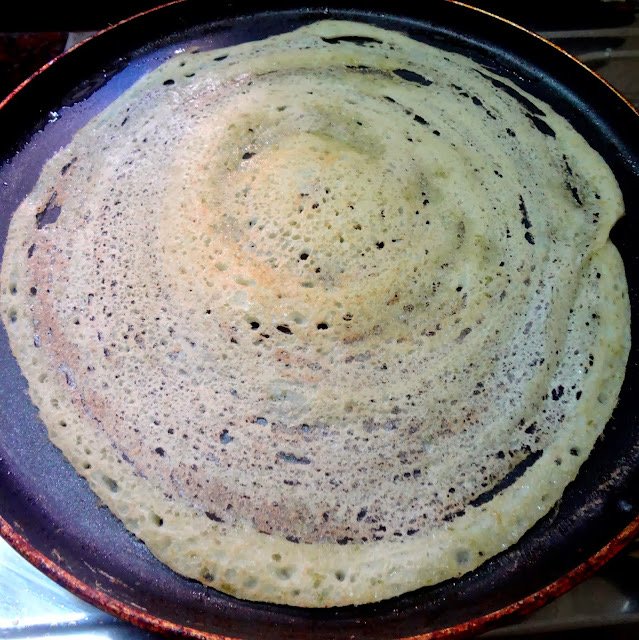Okra Dosa /Vendakkai dosa
Okra dosa
Okra dosa
Okra Dosa is a blessing for those lacking udad dal or seeking a swift dosa option, especially when faced with challenges fermenting dosa batter due to weather conditions. This dosa proves particularly appealing to individuals residing in colder regions, offering a healthful and convenient addition to their weekly menu.
My admiration for this dosa spans various reasons. Beyond being a nutritional powerhouse, it delivers the same delightful combination of crispiness and softness characteristic of traditional rice and udad dal batter dosas. The overall structure remains nearly identical, with the only notable difference being the pleasing light green color.
The name okra is most often used in the United States, with a variant pronunciation, English Caribbean okro. The wordokra is of Nigerian origin and is cognate with ọkwurụ spoken in Nigeria.
Okra is often known as "lady's fingers" outside of Africa. In various Bantu languages, okra is called kingombo or a variant thereof,and this is the origin of its name (quiabo), Spanish (quimbombó or guigambó), Dutch andFrench (gombo), and also possibly of the name "gumbo", used in parts of the United States and English-speaking Caribbean for either the vegetable or a stew based on it. In India and Pakistan, and often in the United Kingdom, it is called by its Hindi/Urdu name, bhindi, bhendi, bendai or bhinda. In Bangladesh and West Bengal, India it is calleddherosh.
In Tamilnadu, India it is called vendai kai. In Andhra Pradesh and Karnataka, India it is called bende kayi. In China, it is called qiu kui. In Middle East (Arabic speakers) it is called bamia or bamyeh.
The products of the plant are mucilaginous, resulting in the characteristic "goo" or slime when the seed pods are cooked; the mucilage contains a usable form of soluble fiber. Some people cook okra this way, others prefer to minimize sliminess; keeping the pods intact, and brief cooking, for example stir-frying, help to achieve this.
Cooking with acidic ingredients such as a few drops of lemon juice, tomatoes, or vinegar may help. Alternatively, the pods can be sliced thinly and cooked for a long time so the mucilage dissolves, as in gumbo. The cooked leaves can also be used as a powerful soup thickener.The immature pods may also be pickled. In the deep south of the United States Okra is a delicacy, especially deep fried in oil, after breading....( WIKI source )
You can very well substitute the normal dosa for this healthy version.
Okra dosa
Ingredients:
1 cup raw rice
1 cup par boiled rice
1/4 cup moong dal ( Pasi parup ) or Udad dal
2 green chillis
small piece of ginger.
Pinch of Asafoetida powder
salt to taste
1 cup chopped fresh tender okras/ladies fingers
Sprigs of curry leaves or Coriander leaves. I just added some coriander leaves chopped fine and added with batter while grinding itself.
Method
Soak the rice and dals together for 3 hours minimum.
After sufficient soaking time, grind the dals with salt, ginger,aafoetida powder.
When the rice and dals are almost ground to a smooth thick batter, add the okras to the batter and continue grinding till the batter is smooth and thick, will not take long.
Remove batter from the grinder/mixie and mix well, the batter will appear thick,pasty, gooey or goopy!! Dont get alarmed as the okras are mucilaginous, it renders the batter pasty.
But when you start making the dosas by ladling the scoop of batter on the griddle, it becomes easy to make the swirls like normal dosa.
Keep the batter to ferment either overnight or for 4 hours .I usually choose to do this dosa during the day , grind by afternoon, and have dosas by late evening as the batter doesn't need the usual long overnight hours of fermentation.
After fermentation , you can prepare the dosa like the usual ones.
Take the thick slightly pasty batter in a scoop and first plop it in the middle of the hot greased griddle, preferably a non stick dosa pan , and then start spreading into circles, you will see the pasty batter will help to make the usual swirls and lots of tiny holes will appear on the surface, showing the fermentation. You should continuously make the circles, without leaving the pan and in one quick move.Just like normal dosa
This dosa is also very easy to remove, flip over.
Serve hot with your choice of chutney or sambarv
Okra dosa
Notes
1. The consistency of the dosa batter can be made like that of rava dosa, by thinning with water and mixing well , but you will not be able to make the swirls, instead pour the batter from outer edge of the pan and as you would in rava dosa , you will get nice thin crispy rava dosa like texture.
2. I prefer to make it like the usual dosa with same consistency.
You can use red chillis and ginger while grinding instead of green chillis, both taste equally good.
3. Instead of using moong da/green gram you can use udad dal/black gram too. I used Moong dal as it soaks well quickly and we can speed up the grinding process. Doesnt make any difference, infact Moong dal is more healthier too.





